CBSE Class 12 Micro Economics Chapter-4 Important Questions - Free PDF Download
Free PDF download of Important Questions with Answers for CBSE Class 12 Micro Economics Chapter 4 - The Theory of the Firm under Perfect Competition prepared by expert Economics teachers from latest edition of CBSE(NCERT) books. Register online for Online tuition on Vedantu.com to score more marks in CBSE board examination.
 Table of Content
Table of ContentStudy Important Questions for Class 12 Economics Chapter 4 – The Theory of the Firm under Perfect Competition
Very Short answer Questions (1 or 2 Marks)
1. Define perfect competition.
Ans: A market with perfect competition has a large number of customers and sellers selling the same product at the same price.
2. Define Monopoly.
Ans: A monopoly is a market arrangement in which a single supplier has complete price control.
3. Condition for producer equilibrium is
a) TR=TVC
b) MC=MR
c) None of above
d) TC=TSC
Ans: (b) MC=MR
4. ____________ is an ideal market?
a) Monopolistic competition
b) Oligopoly
c) Monopoly
d) Perfect competition
Ans: (d) Perfect competition
5. Under which market situation demand curve is linear and parallel to X-axis?
a) Monopoly
b) Perfect competition
c) Oligopoly
d) Monopolistic competition
Ans: (b) Perfect competition
6. If under perfect competition, the price lies below the average cost curve, the firm would?
a) Incur losses
b) Make abnormal profits
c) Make only normal profits
d) Profit cannot be determined
Ans: (a) Incur losses
7. What are the conditions for the long run equilibrium of the competitive firm?
a) P=MR
b) LMC=LAC=P
c) SMC=SAC=LMC
d) All of the above
Ans: (b) LMC=LAC=P
8. A firm can sell as much as it wants at the market price. The situation is related to?
a) Monopoly
b) Monopolistic competition
c) Perfect competition
d) Oligopoly
Ans: (c) Perfect competition
9. What is oligopoly?
Ans: Oligopoly is defined as a market structure characterized by a small number of significant sellers who sell either homogeneous or differentiated commodities.
10. What is product differentiation?
Ans: It is the practice of differentiating products and services on various basis such as style, looks, label, color, size, packaging, brand name, etc., with an objective to make it more attractive and better than the product or service of the competitors.
11. What is the shape of marginal revenue curve under monopoly?
Ans: In a monopoly market, the marginal revenue curve slopes downhill from left to right and is lower than the average revenue curve.
12. What is break – even price?
Ans: The break-even price in a completely competitive market is the price at which a firm earns normal profit (Price =AC ). In the long run, the break-even price is the point at which P=AR=MC.
13. Globalization has made Indian Market as?
a) Buyer market
b) Monopsony market
c) Seller market
d) Monopoly market
Ans: (a) Buyer market
14. When AR=Rs.10 and AC= Rs. 8 the firm makes?
a) Gross profit
b) Normal profit
c) Net profit
d) Supernormal profit
Ans: (d) Supernormal profit
15. A competitive firm in the short run incurs losses. The firm continues production, if?
a)
b)
c)
d)
Ans: (c)
Short Answer Questions - 3 or 4 Marks
16. Why is the demand curve in monopolistically competitive firms likely to be very elastic?
Ans: The demand curve in monopolistically competitive firms is likely to be very elastic. The reason for this is because the products produced by monopolistically competitive enterprises are nearly identical, and the firms have less control over the price. If the items are close replacements of one another, and the product is not differentiated enough, the elasticity of demand becomes strong, making the firm's demand curve very elastic.
17. Explain the implication of free entry and free exit of a firm in a perfect competitive market?
Ans: If firms can enter and exit freely, no firm can achieve an extraordinary profit in the long run. That is, the corporation earns no extraordinary profit in case of freedom of entry and exit, and hence, each company gets a standard profit. In a perfect competition there are large numbers of buyers and sellers.
‘Free Entry’ means that there are no obstacles in the entry of new firms in the market. When the existing businesses are earning abnormal profits, the new firms are influenced due to the profit and they enter the industry. This increases market supply which leads to fall in market price and furthermore profits.
'Freedom to exit' means that there are no obstacles which stop the existing firms from stepping down from the market. The firms attempt to quit when they are dealing with losses. As the firms start to exit, market supply drops, which begins to rise in market price and consequently decreases in losses. The firms do not stop to leave till the losses are eliminated and each remaining firm will be earning just the normal profits.
18. With the help of the diagram, show the effect on equilibrium price and quantity when supply is perfectly inelastic and demand increases & decreases.
Ans: Rise in Demand
When supply is completely inelastic and demand rises, the demand curve shifts to the right. At point, the new demand curve intersects the supply curve at point As a result, prices rise whereas quantity demand remains unchanged.
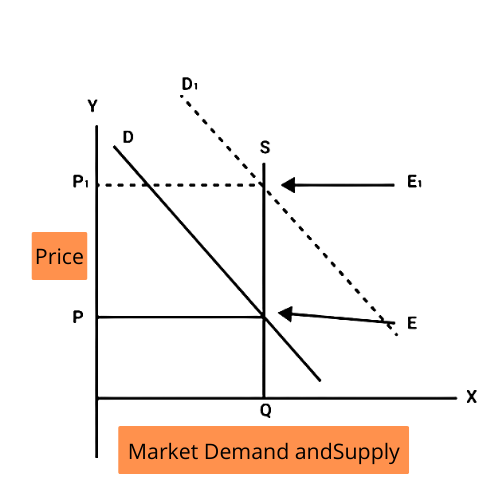
Fall in Demand
In the diagram shown below, demand curve shifts towards left when demand falls and price decreases from but quantity remains same.
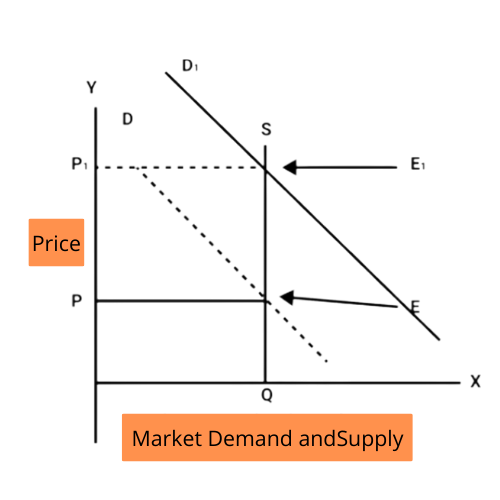
19. Which features of monopolistic competition are monopolistic in nature?
Ans: Monopolistic competition refers to a market situation in which there are a large number of firms selling products that are closely related but distinct.
Large number of sellers: There are a large number of businesses selling products that are related but not identical. Each firm operates independently and has a limited market share. As a result, a single firm has only limited control over the market price. The presence of a large number of businesses creates market competition.
Product Differentiation: Despite the large number of sellers, each firm can exercise some degree of monopoly through product differentiation. Product differentiation is the process of distinguishing products based on their brand, size, color, shape, and so on. A firm's product is a close but not perfect substitute for another firm's product.
Selling costs: Products are differentiated in monopolistic competition, and these differences are communicated to buyers through selling costs. The expenses incurred on marketing, sales promotion, and product advertisement are referred to as selling costs.
Freedom of entry and exit: Firms are free to enter or exit the industry at any time under monopolistic competition. It ensures that a firm does not experience abnormal profits or losses in the long run.
Lack of perfect knowledge: Buyers and sellers do not have a complete understanding of market conditions. Selling costs create an artificial superiority in the minds of consumers, making it difficult for them to evaluate different products on the market. As a result, even if other less expensive products are of equal quality, consumers prefer a specific product (even if it is highly priced).
20. When will the equilibrium price not change even if demand and supply increases?
Ans: When the proportionate rise in demand is exactly equal to the proportionate increase in supply, the equilibrium price remains constant. It is depicted in the diagram below.
Diagram
In this diagram one can see that when both demand and supply increase at an equal level. The price remains unchanged, even though the quantity changes.
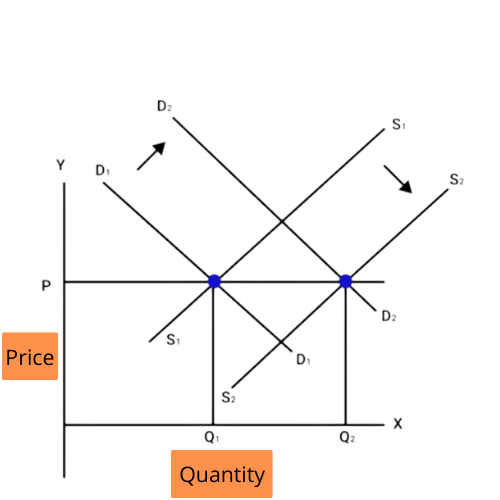
Long Answer Questions (5 or 6 Marks)
21. Distinguish between change in supply and change in quantity supplied. State two factors responsible for change in supply.
Ans: The difference between change in supply and change in quantity supplied is as follows:
Basis | Change in supply | Change in quantity supplied |
Meaning | Change in supply occurs when the supply of a good changes due to changes in all other factors except the price of the item (i.e. the price of the good remains unchanged). | Change in amount supplied occurs when supply changes only as a result of a change in the price of commodities, assuming all other factors remain constant. |
Shifts and Movements | It causes a shift in the firm's supply curve, which might be either rightwards or leftwards. | It causes a shift in the firm's supply curve, which can be either upward or downward. |
Form | Increase and Decrease in supply. | Expansion and contraction of supply. |
Difference in Diagrams - Change in Supply:
The change in supply is depicted in the graphic below. We can see an increase in supply due to reasons other than price, shown through rightward movement.
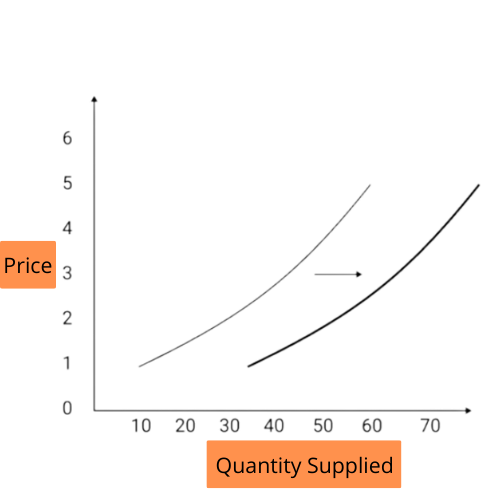
Difference in Diagrams - Change in Quantity Supplied:
A change in quantity delivered would be depicted as an upward movement in the supply curve due to an increase in price.
Take note that this is the supply curve that has been separated on the graph. A distinct quantity is delivered at each point on the curve. So, if we shift from
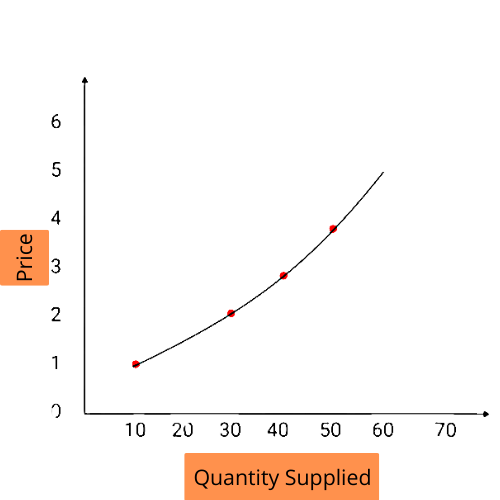
As a result, changes in supply allow manufacturers to sell more (or less) at a given price. Changes in amount supplied, on the other hand, are induced by price changes, causing manufacturers to sell more (or less) at a different price.
Factors are responsible for changes in supply:
Production costs: Input prices and the consequent production costs are inversely related to supply. Changes in input prices and production costs, in other words, create an opposing shift in supply. For example, as wages or labor expenses rise, the supply of goods falls.
Technology: Improvements in manufacturing technology change the supply curve. Improvements in technology, in particular, boost supply, resulting in a rightward shift in the supply curve, that is better the technology, higher the supply.
Other goods prices: Other items' price adjustments are a little more challenging. To begin, in order to influence supply, producers must believe the items are related. What customers believe is unimportant. Ranchers, for example, believe that meat and leather are connected since they both come from a steer.
22. Explain the conditions of a producer’s equilibrium in terms of Marginal Cost and Marginal Revenue. Use a diagram.
Ans: The term "producer's equilibrium" refers to a condition in which a producer produces the amount of output that maximizes earnings. It is a profit-maximizing condition. Under the MR-MC technique, the producer will only reach equilibrium at the level of production if the following conditions are met.
MR = MC
After MR = MC, MC must rise.
At the point of equilibrium, the MC curve must cut the MR curve from below.
The addition to TR from the sale of one additional unit of output is denoted by MR, and the addition to TC is denoted by MC. Firms compare their MR with their MC in order to maximize earnings.
In the diagram, output is indicated on the
When output level is more than OQ, MR < MC, which implies that the firm is making a loss on its last unit of output. Hence, so as to maximize profit, a rational producer will keep decreasing its output as long as MC >MR. Thus, the firm moves towards producing OQ units of output.
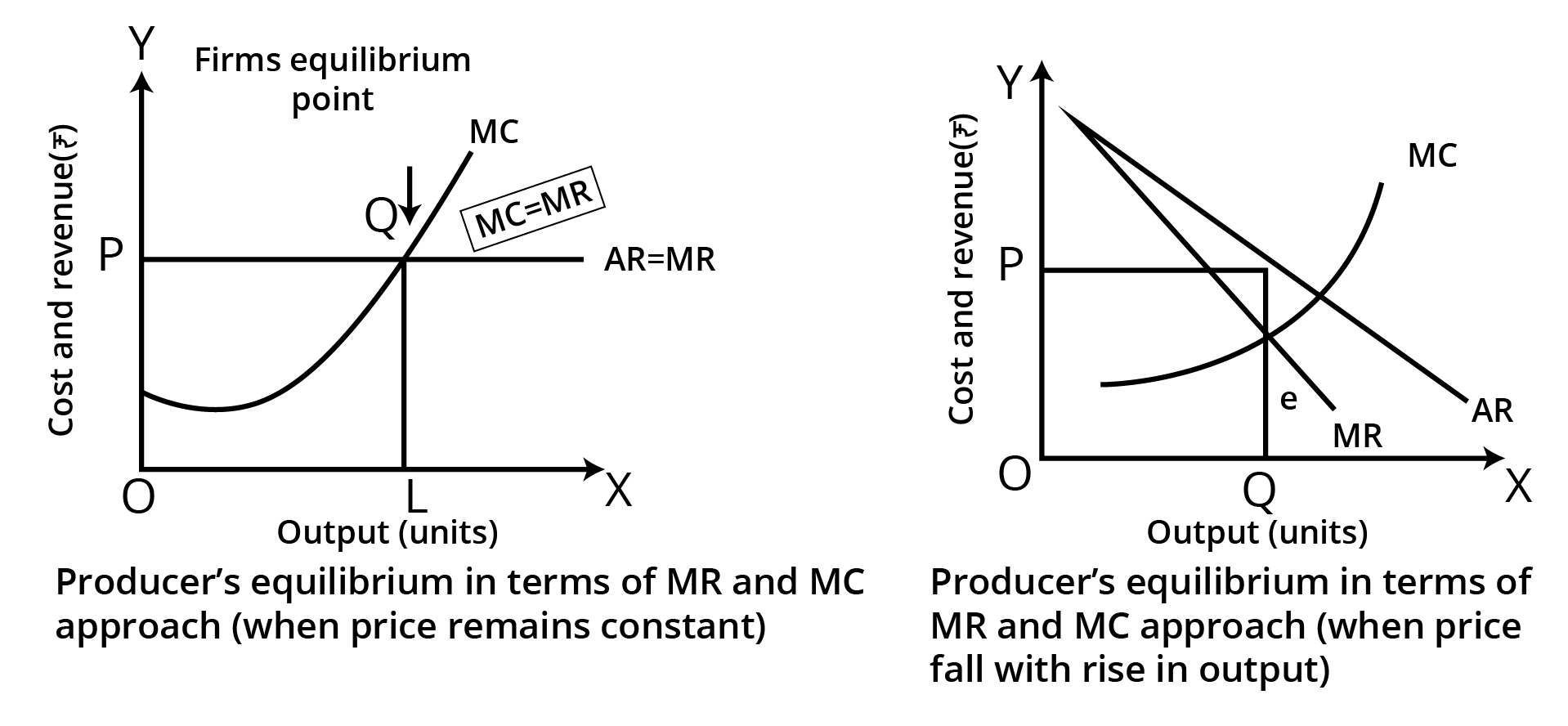
23. When the price of a commodity rises from Rs. 10 to Rs. 11 per unit, its quantity supplied rises by 100 units. Its price elasticity of supply is 2. Calculate its quantity supplied at the increased price.
Ans: Given:
P=10
P1=11
The price elasticity of supply is calculated as
Substitute the known values in the above equation,
Therefore, the quantity supplied at the increase price is calculated as
24. A firm supplies 500 units of a good at a price of Rs. 5 per unit. The price elasticity of supply of good is 2. At what price will the firm supply 700 units?
Ans: Given:
The price elasticity of supply is calculated as
Substitute the known values in the above equation,
Therefore, the new price is calculated as
Therefore, the firm will supply 700 units at Rs. 6 per unit.
Important Study Material Links for Class 12 Microeconomics Chapter 4
S. No | Important Study Material Links for Class 12 Microeconomics Chapter 4 |
1 | Class 12 Microeconomics Chapter 4 The Theory of The Firm Under Perfect Competition Solutions |
2 | Class 12 Microeconomics Chapter 4 The Theory of The Firm Under Perfect Competition Notes |
CBSE Class 12 Economics Important Questions Textbooks
S. No | CBSE Class 12 Economics Important Questions |
1 | Important Questions for CBSE Class 12 Introductory Microeconomics |
2 | Important Questions for CBSE Class 12 Introductory Macroeconomics |
Chapter-wise Links for Microeconomics Class 12 Questions
S. No | CBSE Class 12 Microeconomics Important Questions |
1. | |
2. | |
3. | |
4. |
Related Study Materials Links for Class 12 Microeconomics
Along with this, students can also download additional study materials provided by Vedantu for Microeconomics Class 12–
S. No | Related Study Materials Links for Class 12 Microeconomics |
1. | |
2. | |
3. | |
4. | |
5. |

















